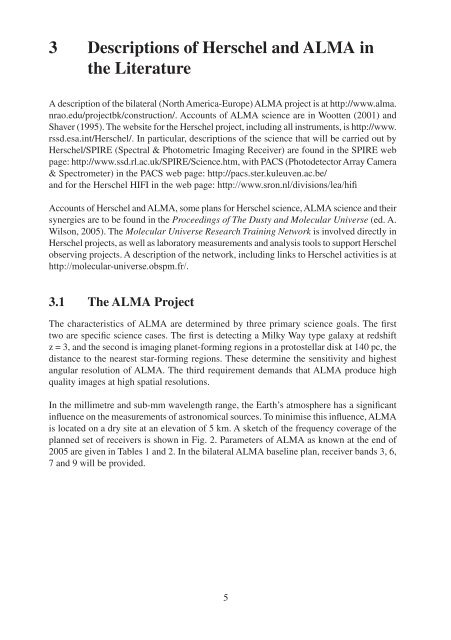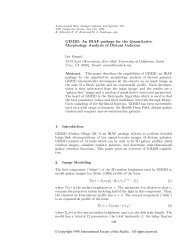4 Comparison of the ALMA and Herschel - ESO
4 Comparison of the ALMA and Herschel - ESO
4 Comparison of the ALMA and Herschel - ESO
Create successful ePaper yourself
Turn your PDF publications into a flip-book with our unique Google optimized e-Paper software.
3 Descriptions <strong>of</strong> <strong>Herschel</strong> <strong>and</strong> <strong>ALMA</strong> in<br />
<strong>the</strong> Literature<br />
A description <strong>of</strong> <strong>the</strong> bilateral (North America-Europe) <strong>ALMA</strong> project is at http://www.alma.<br />
nrao.edu/projectbk/construction/. Accounts <strong>of</strong> <strong>ALMA</strong> science are in Wootten (2001) <strong>and</strong><br />
Shaver (1995). The website for <strong>the</strong> <strong>Herschel</strong> project, including all instruments, is http://www.<br />
rssd.esa.int/<strong>Herschel</strong>/. In particular, descriptions <strong>of</strong> <strong>the</strong> science that will be carried out by<br />
<strong>Herschel</strong>/SPIRE (Spectral & Photometric Imaging Receiver) are found in <strong>the</strong> SPIRE web<br />
page: http://www.ssd.rl.ac.uk/SPIRE/Science.htm, with PACS (Photodetector Array Camera<br />
& Spectrometer) in <strong>the</strong> PACS web page: http://pacs.ster.kuleuven.ac.be/<br />
<strong>and</strong> for <strong>the</strong> <strong>Herschel</strong> HIFI in <strong>the</strong> web page: http://www.sron.nl/divisions/lea/hifi<br />
Accounts <strong>of</strong> <strong>Herschel</strong> <strong>and</strong> <strong>ALMA</strong>, some plans for <strong>Herschel</strong> science, <strong>ALMA</strong> science <strong>and</strong> <strong>the</strong>ir<br />
synergies are to be found in <strong>the</strong> Proceedings <strong>of</strong> The Dusty <strong>and</strong> Molecular Universe (ed. A.<br />
Wilson, 2005). The Molecular Universe Research Training Network is involved directly in<br />
<strong>Herschel</strong> projects, as well as laboratory measurements <strong>and</strong> analysis tools to support <strong>Herschel</strong><br />
observing projects. A description <strong>of</strong> <strong>the</strong> network, including links to <strong>Herschel</strong> activities is at<br />
http://molecular-universe.obspm.fr/.<br />
3.1 The <strong>ALMA</strong> Project<br />
The characteristics <strong>of</strong> <strong>ALMA</strong> are determined by three primary science goals. The first<br />
two are specific science cases. The first is detecting a Milky Way type galaxy at redshift<br />
z = 3, <strong>and</strong> <strong>the</strong> second is imaging planet-forming regions in a protostellar disk at 140 pc, <strong>the</strong><br />
distance to <strong>the</strong> nearest star-forming regions. These determine <strong>the</strong> sensitivity <strong>and</strong> highest<br />
angular resolution <strong>of</strong> <strong>ALMA</strong>. The third requirement dem<strong>and</strong>s that <strong>ALMA</strong> produce high<br />
quality images at high spatial resolutions.<br />
In <strong>the</strong> millimetre <strong>and</strong> sub-mm wavelength range, <strong>the</strong> Earth’s atmosphere has a significant<br />
influence on <strong>the</strong> measurements <strong>of</strong> astronomical sources. To minimise this influence, <strong>ALMA</strong><br />
is located on a dry site at an elevation <strong>of</strong> 5 km. A sketch <strong>of</strong> <strong>the</strong> frequency coverage <strong>of</strong> <strong>the</strong><br />
planned set <strong>of</strong> receivers is shown in Fig. 2. Parameters <strong>of</strong> <strong>ALMA</strong> as known at <strong>the</strong> end <strong>of</strong><br />
2005 are given in Tables 1 <strong>and</strong> 2. In <strong>the</strong> bilateral <strong>ALMA</strong> baseline plan, receiver b<strong>and</strong>s 3, 6,<br />
7 <strong>and</strong> 9 will be provided.<br />
5




